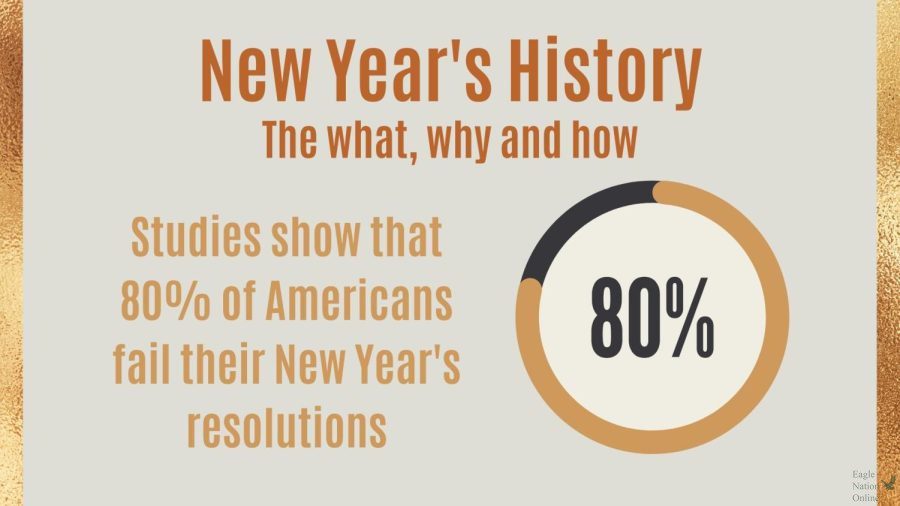New Year’s history — the what, why and how
A graphic created in Canva shows a statistic about New Year’s resolutions. One study from thetimestribune.com showed that 80% of Americans fail their New Year’s resolutions by February. The study also stated that 8% of people keep their resolutions for the full year.
January 19, 2023
Jan. 1 marks the beginning of a new year and a celebration to reflect on growth. Starting with the Babylonians, the worldwide holiday holds much importance and history. New Year’s Day has a multitude of traditions and meanings from multiple cultures. History holds examples. Common traditions – and their meanings – have continued for centuries. While the start of this column started purely over having something covering the holiday, the more I learned the more interested I became.
In today’s generation, it seems the constant pattern and answers include “I don’t know” when asked “why don’t you follow these promises through?” It could just be me, but when I was younger I would make them just for fun and never follow them through. I’d tried the “be more organized” promises and the “study harder” basic answers, but I’d never stick with them. I came up with them in 10 minutes and realized later in life that when things grew to be slightly chaotic, naturally that became my version of ‘organized.’ I even tried to follow “eat healthier,” which was pleasing to my mother, sure, but anyone who knows me would know there is no way I would ever be able to follow through with giving up sweet treats for anything.
Personally, I think we do not follow them through because there are limitless answers to the question “what’s your new year’s resolution?” Making us choose to run before we can walk. Maybe the way to succeed in making a resolution is to keep ourselves in check and aim lower before we aim higher.
History
The Babylonians had been the first to celebrate the new year, marking it on their calendar after the Vernal Equinox in around late March, and to make New Year’s resolutions. Officially, New Year’s started as a holiday with Julius Caesar in 46 B.C. Every month of the Roman calendar was named after one of their gods. January originates from the Greek god Janus – a two-faced god of doors and archways. He was chosen symbolically to represent looking toward the future and reflecting on the past. Later on, the Christians adopted the tradition of reflecting on past mistakes. The Convent Renewal Service is a gathering in Christian history for reflecting, and giving oneself to God fully, created in the 1740s.
Traditions
Sprouting from the international holiday came many traditions. An example is the “Peacock Vow,” which was used in medieval times by knights to renew their chivalry by placing a hand on a peacock. In modern times, people eat foods that represent and are thought to bring good fortune for the coming year. Generally, Americans eat black-eyed peas, and Italians eat lentils. Throughout many Latin American countries as well as Spain, it’s a tradition to eat 12 grapes – one to gain good fortune for each month.
Sweden and Norway hold a tradition of race pudding with a single almond hidden inside, bringing luck to whoever finds it. This tradition is similar to the Mardi Gras tradition of finding a baby figurine in your cake to gain luck and prosperity; originally meaning favor for the fasting season to come, and gaining the title of “king” or “queen” for the night. Many customs involve fireworks and light displays. For example, the ball drop in New York, and the countdowns and broadcasts.
The funny thing about these traditions is that although they are created in the past, they are passed down through generations to generate hope of better years to come.
Resolutions
New Year’s resolutions have been handed from culture to culture. Originally the Babylonians had made them in hopes of pleasing the gods to win favors. During the 17th century, society made resolutions for laughs, finding it funny to make promises to themselves but never keep them. From the 20th century, the types of resolutions made have morphed from hoping to be a better person and centering around religion to forming better outlooks and gaining self-improvement for the year, as well as creating better habits.
The impermanence of resolutions
Writer for Business Insider Amy Morin lists off pressure, no self-monitoring, and a lack of preparation as three reasons people don’t stick to their resolutions. Due to the busy holidays coming to an end, there is no time to actually sit and plan out, thinking about what they could work to improve.
That leads to the stress of trying to keep up with everyone else and disregarding the necessary safeguards to keep one’s willpower strong and monitored. Even overconfidence in one’s ability to keep their resolutions this time around can get in the way of actually succeeding. Self-doubt plays its usual role in the negative outcome of change.
It’s never too late to attempt to make resolutions for the New Year — even if it didn’t work the first time, there’s no harm in trying again. Just make sure you aren’t attempting something you know isn’t possible!

























